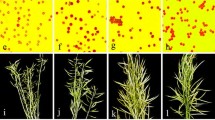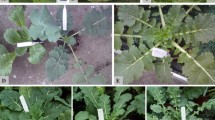Abstract
This paper reports the observation on the intersubgenomic heterosis for seed yield among hybrids between natural Brassica napus (AnAnCnCn) and a new type of B. napus with introgressions of genomic components of Brassica rapa (ArAr). This B. napus was selected from the progeny of B. napus × B. rapa and (B. napus × B. rapa) × B. rapa based on extensive phenotypic and cytological observation. Among the 129 studied partial intersubgenomic hybrids, which were obtained by randomly crossing 13 lines of the new type of B. napus in F3 or BC1F3 to 27 cultivars of B. napus from different regions as tester lines, about 90% of combinations exceeded the yield of their respective tester lines, whereas about 75% and 25% of combinations surpassed two elite Chinese cultivars, respectively. This strong heterosis was further confirmed by reevaluating 2 out of the 129 combinations in a successive year and by surveying hybrids between 20 lines of the new type of B. napus in BC1F5 and its parental B. napus in two locations. Some DNA segments from B. rapa were identified with significant effects on seed yield and yield components of the new type of B. napus in BC1F5 and intersubgenomic hybrids in positive or negative direction. It seems that the genomic components introgressed from B. rapa contributed to improvement of seed yield of rapeseed.



Similar content being viewed by others
References
Akbar M (1989) Chromosomal stability and performance of re-synthesized Brassica napus produced for gain in earliness and short-day response. Hereditas 111:247–253
Ali M, Copeland LD, Elias SG, Kelley JD (1995) Relationship between genetic distance and heterosis for yield and morphological traits in winter canola (Brassica napus L.). Theor Appl Genet 91:118–121
Allard RW (1960) Principles of plant breeding. Wiley, New York, pp 434–443
Becker HC, Engqvist GM, Karlsson B (1995) Comparison of rapeseed cultivars and resynthesized lines based on allozyme and RFLP markers. Theor Appl Genet 91:62–67
Brewbaker JL, Sun WG (1999) Trees and heterosis. In: Coors JG, Pandey S (eds) The genetics and exploitation of heterosis in crops. American Society of Agronomy, Crop Science Society of America, Soil Science Society of America, Madison, pp 463–478
Chen BY, Heneen WK, Jonsson R (1988) Resynthesis of Brassica napus L. through interspecific hybridization between B. alboglabra Bailey and B. campestris L. with special emphasis on seed colour. Plant Breed 101:52–59
Diers BW, McVetty PBW, Osborn TC (1996) Relationship between heterosis and genetic distance based on restriction fragment length polymorphism markers in oilseed rape (Brassica napus L.). Crop Sci 36:79–83
Downey RK, Röbbelen G (1989) Brassica species. In: Röbbelen G, Downey RK, Ashri A (eds) Oil crops of the world. McGraw-Hill, New York, pp 339–362
Fu T (2000) Breeding and utilization of rapeseed hybrid. Hubei Science Technology, Hubei, pp 167–169
Gómez-Campo C, (1999) Biology of Brassica coenospecies. Elsevier, The Netherlands, p 49
Grant I, Beversdorf WD (1985) Heterosis and combining ability estimates in spring-planted oilseed rape (Brassica napus L.). Can J Genet Cytol 27:472–478
Heath DW, Earle ED (1996) Resynthesis of rapeseed (Brassica napus L.): a comparison of sexual versus somatic hybridization. Plant Breed 115:395–401
Heath DW, Earle ED (1997) Resynthesis of low linolenic acid rapeseed (Brassica napus L.) through protoplast fusion. Euphytica 93:339–344
Hoenecke M, Chyi YS (1991) Comparison of Brassica napus and B. rapa genomes based on restriction fragment length polymorphism mapping. In: Proceedings of the 8th international rapeseed congress, vol 4, Saskatchewan, pp 1102–1107
Kräling K (1987) Utilization of genetic variability of resynthesized rapeseed. Plant Breed 99:209–217
Lefort-Buson M, Guillot-Lemoine B, Dattee Y (1987) Heterosis and genetic distance in rapeseed (Brassica napus L.): crosses between European and Asiatic selfed lines. Genome 29:413–418
Li Z, Liu H, Luo P (1995) Production and cytogenetics of intergeneric hybrids between Brassica napus and Orychophragmus violaceus. Theor Appl Genet 91:131–136
Liu H (2000) Genetics and breeding in rapeseed. Chinese Agricultural Universitatis, Beijing, pp 144–177
Liu R, Qian W, Meng J (2002) Association of RFLP markers and biomass heterosis in trigenomic hybrids of oilseed rape (Brassica napus × B. campestris). Theor Appl Genet 105:1050–1057
Lu C, Masahiro K (2001) Fertilization fitness and relation to chromosome number in interspecific progeny between Brassica napus and B. comparative study using current and resynthesized B. napus. Breed Sci 51:73–81
Mackay GR (1977) The introgression of S alleles into forage rape Brassica napus L. from turnip, Brassica campestris L. ssp. rapifera. Euphytica 26:511–519
Mikkelsen TR, Jensen J, Jørgensen RB (1996) Inheritance of oilseed rape (Brassica napus) RAPD markers in a backcross progeny with Brassica campestris. Theor Appl Genet 92:492–497
Morgan CL, Bruce DM, Child R, Ladbrooke ZL, Arthur AE (1998) Genetic variation for pod shatter resistance among lines of oilseed rape developed from synthetic B. napus. Field Crops Res 58:153–165
Namai H (1976) Cytogenetic and breeding studies on the transfer of economic characters by means of interspecific and intergenomic crossing in the tribe Brassiceae of Cruciferae. Mem Fac Agr Tokyo Univ Educ 22:101–171
Namai H, Sarashima M, Hosoda T (1980) Interspecific and intergeneric hybridization breeding in Japan. In: Tsunoda S, Hinata K, Gómez-Campo C (eds) Brassica crop and wild allies. Biology and breeding. Japan Scientific Societies, Tokyo, pp 191–203
Nei M, Li WH (1979) Mathematical model for studying genetic variation in terms of restriction endonucleases. Proc Natl Acad Sci USA 76:5269–5273
Olsson G (1960) Species crosses within the genus Brassica napus L. II. Artificial Brassica napus L. Hereditas 46:351–396
Olsson G, Ellerström S (1980) Polyploidy breeding in Europe. In: Tsunoda S, Hinata K, Gómez-Campo C (eds) Brassica crops and wild allies—biology and breeding. Japan Scientific Societies, Tokyo, pp 167–190
Peng S, Cassman KG, Virmani SS, Sheehy J, Khush GS (1999) Yield potential trends of tropical rice since release of IR8 and the challenge of increasing rice yield potential. Crop Sci 39:1552–1559
Prakash S, Hinata K (1980) Taxonomy, cytogenetics and origin of crop Brassicas, a review. Opera Bot 55:3–57
Prakash S, Raut RN (1983) Artificial synthesis of Brassica napus and its prospects as an oilseed crop in India. Indian J Genet 43:283–191
Prakash S, Takahata Y, Kirti PB, Chopra VL (1999) Cytogenetics. In: Gómez-Campo C (ed) Biology of Brassica coenospecies. Elsevier, The Netherlands, pp 59–90
Qian W, Liu R, Meng J (2003) Genetic effects on biomass yield in interspecific hybrids between Brassica napus and B. rapa. Euphytica 134:9–15
Ren JP, Dickson MH, Earle ED (2000) Improved resistance to bacterial soft rot by protoplast fusion between Brassica rapa and B. oleracea. Theor Appl Genet 100:810–819
Riaz A, Li Q, Quresh Z, Swati MS, Quiros CF (2001) Genetic diversity of oilseed Brassica napus inbred lines on sequence-related amplified polymorphism and its relation to hybrid performance. Plant Breed 120:411–415
Rosén B, Halldén C, Heneen WK (1988) Diploid Brassica napus somatic hybrids: characterization of nuclear and organellar DNA. Theor Appl Genet 76:197–203
SAS Institute (1992) SAS technical report. SAS statistics software: changes and enhancements. Release 6.07. SAS Institute, Cary
Schenck HR, Röbbelen G (1982) Somatic hybrids by fusion of protoplasts from Brassica oleracea and B. campestris. Z Pflanzenz 89:278–288
Schiemann E (1932) Entstehung der Kulturpflanzen. Handb Vererbwis 3:271–288
Schranz ME, Osborn TC (2000) Novel flowering time variation in the resynthesized polyploid Brassica napus. J Hered 91:242–246
Shiga T (1970) Rapa breeding by interspecific crossing between Brassica napus and Brassica campestris in Japan. Jpn Agric Res Quart 5:5–10
Sinskaya EN (1928) The oleiferous plants and root crops of the family Cruciferae. Bull Appl Bot Genet Plant Breed 9:641–648
Song KM, Osborn TC, Williams PH (1988) Brassica taxonomy based on nuclear restriction fragment length polymorphism (RFLP) 1.Genome evolution of diploid and amphidiploid species. Theor Appl Genet 75:784–794
Song KM, Lu P, Tang K, Osborn TC (1995) Rapid genome change in synthetic polyploids of Brassica and its implication for polyploid evolution. Proc Natl Acad Sci USA 92:7719–7723
Sun VG (1943) Heterosis between Brassica species. Zhong Hua Nong Xue Hui Bao 175:35–38
Sundberg E, Landgren M, Glimelius K (1987) Fertility and chromosome stability in Brassica napus resynthesized by protoplast fusion. Theor Appl Genet 75:96–104
Tsunoda S (1980) Ecophysiology of wild and cultivated froms in Brassica and allied genera. In: Tsunoda S, Hinata K, Gómez-Campo C (eds) Brassica crop and wild allies. Biology and breeding. Japan Scientific Societies, Tokyo, pp 109–120
UN (1935) Genomic analysis in Brassica with special reference to the experimental formation of B. napus and peculiar mode of fertilization. Jpn J Bot 7:389–452
Vos P, Hogegers R, Bleeker M, Reijians M, Lee T, Hornes M, Frijters A, Pot J, Peleman J, Kuiper M, Zabeau M (1995) AFLP: a new technique for DNA fingerprinting. Nucleic Acids Res 23:4407–4417
Xu FS, Wang YH, Meng J (2001) Mapping boron efficiency gene(s) in Brassica napus using RFLP and AFLP markers. Plant Breed 120:319–324
Yuan LP (1994) Increasing yield potential in rice by exploitation of heterosis. In: Virmani SS (ed) Hybrid rice technology, new developments and future prospects. IRRI, Los Banos, Philippines, pp 1–6
Yuan LP (1997) Hybrid rice breeding for super high yield. Hybrid Rice 12(6):1–6
Yuan LP (1998) Hybrid rice breeding in China. In: Virmani SS, Siddiq EA, Muralidharan K (eds) Advances in hybrid rice technology. Proceedings of the 3rd international symposium on Hybrid Rice, Hyderabad, India, 14–16 November 1996. IRRI, Los Banos, Philippines, pp27–33
Zhang Q, Gao YJ, Yang SH, Ragab RA, Saghai MA, Li ZB (1994) A half-diallel analysis of heterosis in elite hybrid rice based on RFLPs and microsatellites. Theor Appl Genet 89:185–192
Zhao J, Becker HC (1998) Genetic variation in Chinese and European oilseed rape (B. napus) and turnip rape (B. campestris) analysis with isozymes. Acta Agron Sinica 24:213–220
Zhou Y, Scarth R (1995) Microspore culture of hybrids between Brassica napus and B. campestris. Acta Bot Sinica 37:848–855
Acknowledgements
This work was supported by National 863 High Technology Program in China and Special Research Fund for the Doctoral Program of Higher Education. The authors gratefully acknowledge Professor J. Wu for assistance in plant selection. We also thank Dr. Christian Jung, Dr. Martin Frauen, Dr. Jianwei Zhao, and Dr. Jinguo Hu for critically reading the manuscript.
Author information
Authors and Affiliations
Corresponding author
Additional information
Communicated by H.C. Becker
Rights and permissions
About this article
Cite this article
Qian, W., Chen, X., Fu, D. et al. Intersubgenomic heterosis in seed yield potential observed in a new type of Brassica napus introgressed with partial Brassica rapa genome. Theor Appl Genet 110, 1187–1194 (2005). https://doi.org/10.1007/s00122-005-1932-9
Received:
Accepted:
Published:
Issue Date:
DOI: https://doi.org/10.1007/s00122-005-1932-9




